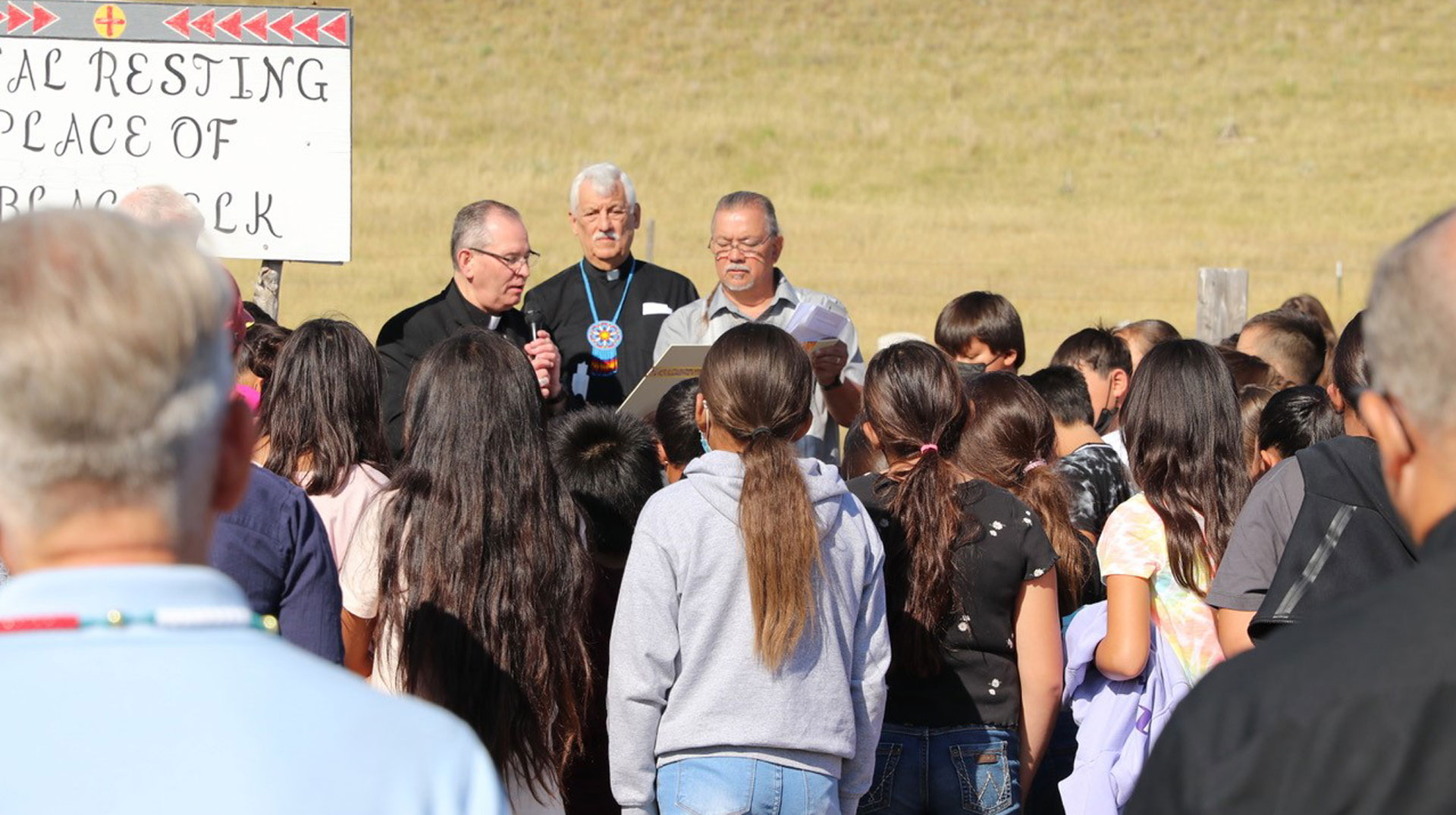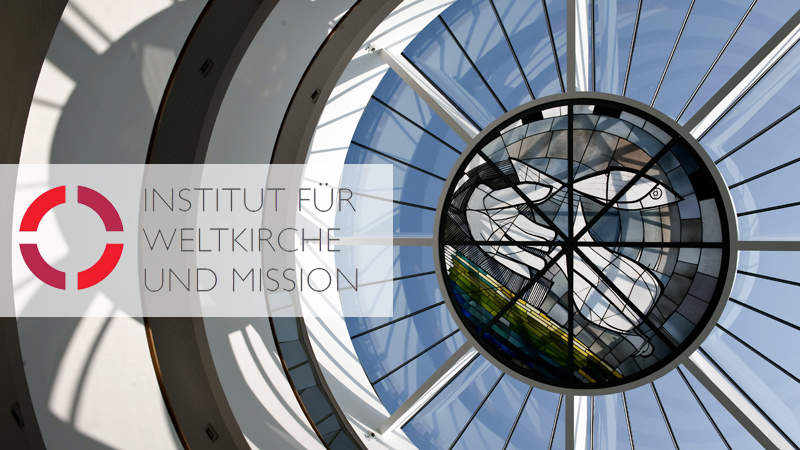
People Are More Important Than Ideas: Catholicism, Colonialism, and Historical Reckoning
Pine Ridge ‐ Arbeiten an einem früheren Kirchen-Internat für Indigene, das Teil der staatlichen Assimilationspolitik war? Als der Jesuit William Critchley-Menor seinen neuen Job antritt, schämt er sich zunächst. Doch Begegnungen mit Lakota lehren ihn: Er geht von falschen Grundannahmen aus. [Englisch]
Aktualisiert: 28.04.2025
Lesedauer:
Die Serie
Teil 8 der Missionskeulen-Serie. Die vergangenen Beiträge beleuchten die komplexe Aufarbeitung der Missionsgeschichte im kolonialen Kontext, das Forschungsprojekt Missiosgeschichtliche Sammlungen, die Herkunft der Keule, die Arbeit deutscher Jesuiten bei den Lakota-Sioux, die Erinnerung an den Jesuiten Eugen Büchel, zwei sehr unterschiedliche Lakota-Kunstsammlungen sowie die Suche der Red Cloud Indian School nach der Wahrheit.
By William Critchley-Menor, SJ
The American Southerner and novelist William Faulker wrote, “The past is never dead. It's not even past.” He was right. The experiences of the past shape our present.
I work at Mahpiya Luta Owayawa – Red Cloud School on the Pine Ridge Indian Reservation in South Dakota. Red Cloud, formerly known as Holy Rosary Mission, is a former Indian boarding school founded by Germain Jesuits and Franciscan sisters in 1888.
HTML-Elemente (z.B. Videos) sind ausgeblendet. Zum Einblenden der Elemente aktivieren Sie hier die entsprechenden Cookies.
After its founding, Holy Rosary quickly became affiliated with the U.S. Government’s project of cultural genocide and assimilation for the ultimate purpose and land and resource theft. This meant that, in order to receive federal funding for the school, the Jesuits needed to follow guidelines of the U.S. genocidal project, which they willingly did. This meant suppression of Lakota language and culture, the forceful separation of children from families, and the racialized and violent teaching tactics.
Red Cloud is trying to reckon with this history and part of my Jesuit formation has included the privileged, but difficult experience of working directly on this project of Truth and Healing.
When I first came to Red Cloud, I had an idea of what the ethical implications of this history were. I saw the Church as morally dubious and assumed that healing would require the Jesuits to potentially leave the Reservation or at least tuck our tail between our legs in order for the “Lakota people” to take charge. Implicit to this idea, however, was the assumption that “Catholic” and “Lakota” were different categories, or even that “Jesuit” and “Lakota” were inherently different categories.
A number of experiences challenged these initial assumptions.
Ongoin trauma
In my first year, the Catholic parishes on the Reservation went through a synodal process to adapt to the current climate. This included a significant number of talking circles with Lakota parishioners. In one conversation, a couple lambasted the Church for its complicity in cultural genocide. They stopped attending Mass because of the heightened consciousness about the boarding school era. In the same conversation, they shared their anger that the Church changed its teaching on the teaching on limbo (a centuries old teaching on the ultimate destination of babies who die before they can be baptized). It was changed by Pope Benedict XVI in 2007 to declare that unbaptized babies can go to heaven, and are not left in an eternal state of limbo. The couple was frustrated that the Pope had changed the teaching.
There was, without a sense of internal contradiction, both a criticism of the Church’s historical actions and alignment with the U.S. Government and an anger with the Church for changing a traditional teaching that the couple found significant and meaningful at an important time in their life. So they asked: “How dare this Church exist and have been like it was?” And at the same time ask, “How dare this Church change? I want it the way it was!”
These individuals held in tandem both the right and ability to criticize the Church for its past and present without conceding that it was useless or failed to provide any sense of meaning and solace to them.

Important protagonists of the search for truth and healing: The Elders
The complexity of our history as a former Indian boarding school has meant a significant amount of controversy over how Catholicism is practiced and taught in our school today. One big question has been over Mass attendance. Should we require kids to go to Mass or is this just a vestige of colonial practices of forced assimilation?
For me, the easy and clear perspective when I first got here was that we should just tone down Catholicism, stop asking kids to go to Mass. I thought that in order for Lakota culture and identity to rise, Catholicism would need to dampen. Again, this was rooted in a mindset that “Catholic” and “Lakota” were inherently different.
A number of my close Lakota friends who worked at the school, or parishioners, however, were angry that the Jesuits weren’t standing up more for the Catholic identity of the school. Their families had been Catholic for generations. They wanted their children or other children to grow up in a Catholic school, which of course meant regular Mass attendance.
Looking for truth and healing
I began to realize that the ideas I held both about race and religion were rooted more in social, ethical norms than they were in the lived histories and complexities of the families and people I was working with.
I was quickly taught that my mindset that “Lakota” and “Catholic” or even “Lakota” and “white” were different or essentially contradictory or conflicting categories was itself colonial. The idea that Catholicism is only colonial or inherently “white,” dishonored the Lakota people for whom Catholicism is deeply meaningful.
To persist in these mindsets is to ask Lakota people, and others, to fit neatly into categories that are not consistent with reality. It violates the complexity that is inherent to every person’s life. In essence, it is a repetition of troubled history to say who can or can’t be or and how they should or shouldn’t be “Catholic” or “Lakota” or “Jesuit.”

Schülerinnen und Schüler der Red Cloud School beten am Grab von Nicholas Black Elk. Mit dabei: Der vormalige Bischof von Rapid City, Peter Muhich sowie der Generalobere der Gesellschaft Jesu, Arturo Sosa.
In his encyclical Evangelli Gaudium, Pope Francis writes, “There exists a constant tension between ideas and realities…There has to be continuous dialogue between the two, lest ideas become detached from realities.” Ideas get worked out in reality. Reality is not worked out by ideas.
Ideas, when divorced too much from realities, can lead us back to a form of historical reckoning that dishonors the complexity of victims' experiences by asking them to be devoid of any nuance.
I’m a white Jesuit teaching English and Theology at a former Indian boarding school. The potential ethical implications of this I once found troubling. But this tendency was rooted in ideas about race, history, and a sense of guilt and shame that would ultimately alienate me from my students and collaborators.
Shared responsibility
My experience in a classroom environment and in the community project of Truth and Healing, is based on relationships more than it is based on race. What I’ve learned from many of my students and from my Lakota coworkers is that my responsibility and their responsibility is the same. It is to study, understand, and then change the unjust conditions we live within: chronic poverty and economic isolation.
Complex human lives and relationships are a better starting point than our fixed ideas. We all have a shared responsibility to change the conditions of our world that allow for such devastating inequality and not to let blame, guilt, dramatic or performative ethics and rhetoric distract us.
Nicholas Black Elk, the holy man of the Oglala Lakota who is in the process of canonization for sainthood in the Catholic Church is the source of some controversy. Could he really be Catholic? Did he just pretend to be Catholic as a strategy in order to gain respect and influence on the reservation? Did he forsake his Lakota spiritual practices and beliefs when he became Catholic?
„Complex human lives and relationships are a better starting point than our fixed ideas.“
These are natural questions because Black Elk breaks our ideas apart and he provides a challenge to the categories we’d like to use to deal with our present moment.
But as his 7th great grandson, Maka Black Elk says, “those who feel he wasn’t truly Catholic or those who feel he completely abandoned his Lakota spiritual traditions have simply not taken into account the words and actions of Black Elk himself.” His relatives attest that he prayed the rosary and he prayed with the pipe until he died.
What Black Elk, who was a mystic, reminds us is that while people and realities are more important than ideas, mysticism and mystery are more important than all. These humble us and open us to new imaginations and possibilities.
The author
William Critchley-Menor, SJ is a Jesuit of the United States Midwest Province. He received a Master’s degree in American Studies from St. Louis University where he researched the history of racism in the U.S. Catholic Church. He currently works at Mahpiya Luta - Red Cloud, a Jesuit high school on the Pine Ridge Indian Reservation in South Dakota.
Hinweis zum Titelbild
Das Beitragsbild zeigt das ehemalige Oberhaupt der Oglala Sioux, Cecilia Fire Thunder, neben dem Generaloberen der Jesuiten, Arturo Sosa SJ, in der Mahpiya Luta Owayawa - Red Cloud School in South Dakota.

Die Missionskeule. Eine Serie.
- Die Missionskeule: Eine internationale Spurensuche
- „Wie kommt die Indianer-Keule zu den Jesuiten?“ und andere Fragen der Projektstelle Missionsgeschichtliche Sammlungen
- Der Weg der Sioux-Steinhammerkeule: Wo sie angefertigt wurde – und wozu
- Deutsche Jesuiten bei den Lakota-Sioux – Eine vielschichtige Beziehung
- Respekt für Respekt: Eugen Büchel in Pine Ridge
- Sammeln und Ausstellen für die Lakota
- Die Suche nach der Wahrheit an der Red Cloud Indian School
- People Are More Important Than Ideas: Catholicism, Colonialism, and Historical Reckoning
- Indigene Spiritualität und christlicher Kontext – eine Schieflage?
- Nicholas Black Elk: Auf der Suche nach Erfüllung einer Vision
- Indigene Perspektiven auf Nicholas Black Elk
- tbd.
HTML-Elemente (z.B. Videos) sind ausgeblendet. Zum Einblenden der Elemente aktivieren Sie hier die entsprechenden Cookies.

Diese Serie entstand in Zusammenarbeit mit dem Institut für Weltkirche und Mission der Philosophisch-Theologischen Hochschule Sankt Georgen.
Inhaltliche Planung und Mitarbeit: Dr. Markus Scholz, IWM | Redaktion: Damian Raiser, weltkirche.de
Die Beiträge dieser Serie spiegeln ausschließlich die Meinung der Autorinnen und Autoren wieder.
